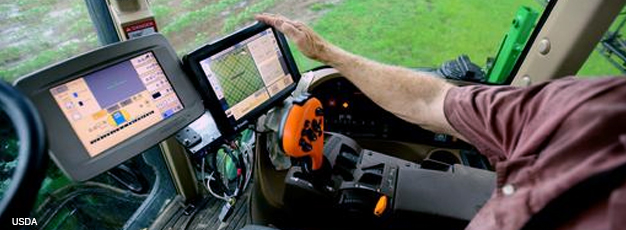“Iowa is the nation’s top pork producer. California comes nowhere close, yet its proposed...
Precision Agriculture Continues Its Advance

Farmers use soil, sun, water and nutrients that have existed for millions of years to produce food that sustains people around the world. But one often overlooked aspect of farming is the evolution of agricultural technology.
Advancements in knowledge, biology and technology have enabled farmers to produce more food with fewer resources for 12,000 years. The technological advancements of recent decades make the gains of the previous 11,000 years seem small.
When agriculture began at the end of the Stone Age there were about 5 million people in the world. Few, if any, farmers were feeding people beyond their extended family.
Farmers now use technology to plant and harvest mile-long fields with equipment guided by satellites for sub-inch accuracy. That enables them to feed about 8 billion people with fewer resources than ever before. The term “precision agriculture” means managing, tracking or enhancing crop- or livestock-production inputs at increased accuracy to improve efficiencies, quality and yield, as well as positively impact environmental stewardship.
Pierre Robert founded the University of Minnesota-Precision Agriculture Center and is sometimes referred to as “the father of precision agriculture.” He conducted some of the earliest research regarding soil variability. In 1983, he was the first person to research variable-rate fertilizer spreading, which acknowledges that different areas of a field have different crop yields and thus different nutrient requirements to produce optimal yields. That understanding eventually led to the variable-rate field-management systems farmers now use.
American farmers use variable-rate technology to plant from 5 percent to 25 percent of total U.S. planted acreage for winter wheat, cotton, sorghum and rice, according to the U.S. Department of Agriculture’s Economic Research Service. The first yield monitor was created in 1992 and data would soon become the “new crop” of the 21st century. Yield monitors enable farmers to record changes in crop yields throughout an entire field. The data can be paired with grid sampling. Farmers can take soil samples from grid points, create maps and make adjustments needed to improve yields.
The remaining piece of the puzzle was how to make variable-rate technology more efficient. Auto-guidance systems using global-positioning-system technology revolutionized the way farmers operate machinery. By the early 2000s the pace of precision farming quickened. The majority of corn, cotton, rice, sorghum, soybeans and winter-wheat acres are now planted using auto guidance.
Global-positioning systems allow for more-efficient use of inputs. They deliver exactly what a plant needs and where it’s needed, reducing waste and runoff.
Most precision-agriculture systems currently use real-time-kinematic – RTK – positioning signals. Those satellite signals use measurements from the signal’s carrier wave, in addition to information sent from a base station, to correct errors in positioning, for sub-inch accuracy. The systems are capable of using a wide-area-augmentation system signal with 6- to 8-inch accuracy as a backup if there are problems with real-time-kinematic signals.
The technology can be used for tillage, planting, harvesting, spraying and many other activities. It’s used to collect data regarding soil temperature, soil moisture, seeding depth, seeds per acre, yield and more. The data are accumulated and can be used to provide production performance in time. Topography data also can be gathered and used to design tile-drainage systems that help to more-efficiently manage water.
RTK signals can be accessed via satellite or internet connections. But a private wireless 5G system with precision-agriculture capabilities could cost about $55,000, according to a May 2022 CoBank report. That includes radio-access-network equipment, a base tower and labor. Recurring costs such as subscriptions would require an additional $6,000 annually.
When the systems work, they’re more effective and efficient than ever. But when things go wrong, downtime is expensive and expertise is often needed to troubleshoot problems. Access to technicians is as important to an operation as the satellites used to deliver the signal.
EDITOR’S TAKE:
This article provides a great history and background of precision ag and the important technological improvements along the way. The adoption of precision ag is important to most farmers today, even smaller to mid-sized farmers. The ability to cut production costs vis-a-vis variable rate applications provides huge savings. Yield data helps determine what seed populations and fertilizer applications are optimal on various soil types. In addition, yield data helps with marketing decisions and determining profitability from every square inch of a farm. Overall, precision ag has made major strides in helping farmers adapt to many challenges, including environmental regulations. But the future holds even more promise as new ways to improve plant genetics, more on-the-spot data analysis, etc., continue this exciting journey. Be sure you let farmers in your area know that the technology you offer in the trucks they use on their farm can help improve efficiency and profitability – especially when your top-notch parts and service departments help them maintain those vehicles.








